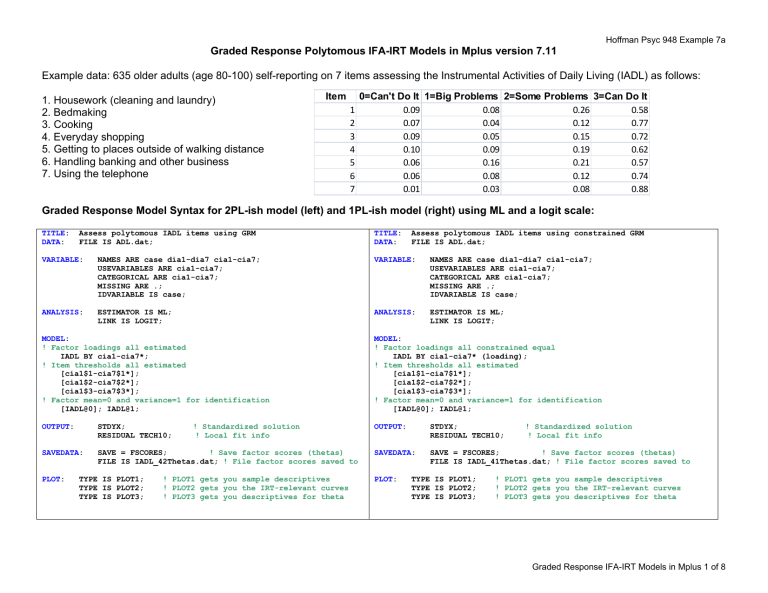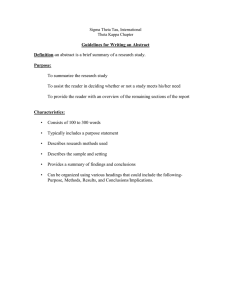
Hoffman Psyc 948 Example 7a Graded Response Polytomous IFA-IRT Models in Mplus version 7.11 Example data: 635 older adults (age 80-100) self-reporting on 7 items assessing the Instrumental Activities of Daily Living (IADL) as follows: 1. Housework (cleaning and laundry) 2. Bedmaking 3. Cooking 4. Everyday shopping 5. Getting to places outside of walking distance 6. Handling banking and other business 7. Using the telephone Item 1 2 3 4 5 6 7 0=Can't Do It 1=Big Problems 2=Some Problems 3=Can Do It 0.09 0.08 0.26 0.58 0.07 0.04 0.12 0.77 0.09 0.05 0.15 0.72 0.10 0.09 0.19 0.62 0.06 0.16 0.21 0.57 0.06 0.08 0.12 0.74 0.01 0.03 0.08 0.88 Graded Response Model Syntax for 2PL-ish model (left) and 1PL-ish model (right) using ML and a logit scale: TITLE: DATA: Assess polytomous IADL items using GRM FILE IS ADL.dat; TITLE: DATA: Assess polytomous IADL items using constrained GRM FILE IS ADL.dat; VARIABLE: NAMES ARE case dia1-dia7 cia1-cia7; USEVARIABLES ARE cia1-cia7; CATEGORICAL ARE cia1-cia7; MISSING ARE .; IDVARIABLE IS case; VARIABLE: NAMES ARE case dia1-dia7 cia1-cia7; USEVARIABLES ARE cia1-cia7; CATEGORICAL ARE cia1-cia7; MISSING ARE .; IDVARIABLE IS case; ANALYSIS: ESTIMATOR IS ML; LINK IS LOGIT; ANALYSIS: ESTIMATOR IS ML; LINK IS LOGIT; MODEL: ! Factor loadings all estimated IADL BY cia1-cia7*; ! Item thresholds all estimated [cia1$1-cia7$1*]; [cia1$2-cia7$2*]; [cia1$3-cia7$3*]; ! Factor mean=0 and variance=1 for identification [IADL@0]; IADL@1; MODEL: ! Factor loadings all constrained equal IADL BY cia1-cia7* (loading); ! Item thresholds all estimated [cia1$1-cia7$1*]; [cia1$2-cia7$2*]; [cia1$3-cia7$3*]; ! Factor mean=0 and variance=1 for identification [IADL@0]; IADL@1; OUTPUT: STDYX; RESIDUAL TECH10; OUTPUT: STDYX; RESIDUAL TECH10; SAVEDATA: SAVE = FSCORES; ! Save factor scores (thetas) FILE IS IADL_42Thetas.dat; ! File factor scores saved to SAVEDATA: SAVE = FSCORES; ! Save factor scores (thetas) FILE IS IADL_41Thetas.dat; ! File factor scores saved to PLOT: TYPE IS PLOT1; TYPE IS PLOT2; TYPE IS PLOT3; ! Standardized solution ! Local fit info ! PLOT1 gets you sample descriptives ! PLOT2 gets you the IRT-relevant curves ! PLOT3 gets you descriptives for theta PLOT: TYPE IS PLOT1; TYPE IS PLOT2; TYPE IS PLOT3; ! Standardized solution ! Local fit info ! PLOT1 gets you sample descriptives ! PLOT2 gets you the IRT-relevant curves ! PLOT3 gets you descriptives for theta Graded Response IFA-IRT Models in Mplus 1 of 8 Hoffman Psyc 948 Example 7a Graded Response Model 2PL-ish Model Fit (left) and 1PLish Model Fit (right) using ML logit: MODEL FIT INFORMATION MODEL FIT INFORMATION Number of Free Parameters 28 Loglikelihood H0 Value -2523.585 Information Criteria Akaike (AIC) Bayesian (BIC) Sample-Size Adjusted BIC (n* = (n + 2) / 24) 5103.171 5227.828 5138.931 Chi-Square Test of Model Fit for the Binary and Ordered Categorical (Ordinal) Outcomes** Pearson Chi-Square Value Degrees of Freedom P-Value Number of Free Parameters Loglikelihood H0 Value 5226.620 5324.565 5254.717 Chi-Square Test of Model Fit for the Binary and Ordered Categorical (Ordinal) Outcomes** Pearson Chi-Square Value Degrees of Freedom P-Value 2650.119 16321 1.0000 Likelihood Ratio Chi-Square Value Degrees of Freedom P-Value 676.937 16317 1.0000 ** Of the 48600 cells in the latent class indicator table, 38 were deleted in the calculation of chi-square due to extreme values. -2591.310 Information Criteria Akaike (AIC) Bayesian (BIC) Sample-Size Adjusted BIC (n* = (n + 2) / 24) 1876.488 16317 1.0000 Likelihood Ratio Chi-Square Value Degrees of Freedom P-Value 22 803.028 16321 1.0000 ** Of the 48600 cells in the latent class indicator table, 40 were deleted in the calculation of chi-square due to extreme values. This error message indicates that these 2 sets of chi-squares are not on the same scale. We need to test the -2LL difference instead. Does the 2PL-ish version of the GRM fit better than the 1PL-ish version? −2523.585*-2 = 5047.170 −2591.310*-2 = 5182.620 −2ΔLL = 135.45, df = 6, p < .0001 AIC and BIC are smaller for 2PL, too Graded Response IFA-IRT Models in Mplus 2 of 8 Hoffman Psyc 948 Example 7a 3 differently scaled solutions from ML logit (2 given, 1 calculated in excel) – all provide the exact same predictions! UNSTANDARDIZED MODEL RESULTS (IFA MODEL SOLUTION) Estimate S.E. Est./S.E. Two-Tailed P-Value FACTOR LOADINGS = CHANGE IN LOGIT(Y) PER UNIT CHANGE IN THETA IADL BY CIA1 6.846 0.841 8.140 0.000 CIA2 5.200 0.555 9.363 0.000 CIA3 4.613 0.456 10.119 0.000 CIA4 5.701 0.612 9.312 0.000 CIA5 3.556 0.298 11.950 0.000 CIA6 2.897 0.261 11.094 0.000 CIA7 1.778 0.209 8.512 0.000 THRESHOLDS = EXPECTED LOGIT(Y=0) WHEN THETA IS 0 (MEAN OF SAMPLE) CIA1$1 -9.808 1.138 -8.620 0.000 CIA1$2 -6.460 0.799 -8.088 0.000 CIA1$3 -1.238 0.384 -3.226 0.001 CIA2$1 -8.145 0.794 -10.257 0.000 CIA2$2 -6.313 0.618 -10.219 0.000 CIA2$3 -3.737 0.441 -8.480 0.000 CIA3$1 -6.841 0.613 -11.162 0.000 CIA3$2 -5.194 0.480 -10.810 0.000 CIA3$3 -2.572 0.330 -7.792 0.000 CIA4$1 -7.454 0.747 -9.975 0.000 CIA4$2 -4.635 0.514 -9.026 0.000 CIA4$3 -1.426 0.327 -4.366 0.000 CIA5$1 -6.578 0.494 -13.314 0.000 CIA5$2 -3.041 0.273 -11.155 0.000 CIA5$3 -0.681 0.203 -3.354 0.001 CIA6$1 -5.538 0.411 -13.486 0.000 CIA6$2 -3.583 0.285 -12.554 0.000 CIA6$3 -2.044 0.219 -9.344 0.000 CIA7$1 -5.810 0.472 -12.315 0.000 CIA7$2 -4.398 0.322 -13.673 0.000 CIA7$3 -2.951 0.237 -12.457 0.000 STDYX MODEL RESULTS (IFA MODEL SOLUTION) Estimate S.E. Est./S.E. Two-Tailed P-Value FACTOR LOADINGS IN STANDARDIZED METRIC = loading*SD(Theta)/SD(Y) IADL BY CIA1 0.967 0.008 124.093 0.000 CIA2 0.944 0.011 86.315 0.000 CIA3 0.931 0.012 75.583 0.000 CIA4 0.953 0.009 101.294 0.000 CIA5 0.891 0.015 57.872 0.000 CIA6 0.848 0.022 39.402 0.000 CIA7 0.700 0.042 16.689 0.000 (rest omitted) USING RESULTS FROM IFA MODEL (LEFT PANEL): IFA model: Logit(y=1) = –threshold + loading(Theta) Threshold = expected logit of (y=0) for someone with Theta=0 When *-1, threshold becomes intercept: expected logit for (y=1) instead Loading = regression of item logit on Theta For 4-category responses, the sub-models look like this: Logit(y= 0 vs 123) = -threshold$1 + loading(Theta) Logit(y= 01 vs 23) = -threshold$2 + loading(Theta) Logit(y= 012 vs 3) = -threshold$3 + loading(Theta) IFA Models: $1 Logit(CIA1=0 vs 123)= 9.808 + 6.846(Theta) if Theta=0, prob=.99994 $2 Logit(CIA1=01 vs 23)= 6.460 + 6.846(Theta) if Theta=0, prob=.99844 $3 Logit(CIA1=012 vs 3)= 1.238 + 6.846(Theta) if Theta=0, prob=.77522 $1 if Theta=-1, logit= 2.962, prob= .95083 $2 if Theta=-1, logit= -0.386, prob= .40468 $3 if Theta=-1, logit= -5.608 prob= .00365 RESULTS FROM IRT MODEL MUST BE CALCULATED BY YOU! IRT model: Logit(y) = a(theta – difficulty) a = discrimination (rescaled slope) = loading b = difficulty (location on latent metric) = threshold/loading My calculations (see spreadsheet): CIA1 loading = 6.846 a discrimination = 6.846 CIA1 threshold$1 = -9.808/6.846 b difficulty$1 = -1.433 CIA1 threshold$2 = -6.460/6.846 b difficulty$2 = -0.944 CIA1 threshold$3 = -1.238/6.846 b difficulty$3 = -0.181 For 4-category responses, the sub-models look like this: $1 Logit(y= 0 vs 123) = a(theta – difficulty$1) $2 Logit(y= 01 vs 23) = a(theta – difficulty$2) $3 Logit(y= 012 vs 3) = a(theta – difficulty$3) IRT Models: $1 Logit = 6.846(Theta - -1.433) $2 Logit = 6.846(Theta - -0.944) $3 Logit = 6.846(Theta - -0.181) Graded Response IFA-IRT Models in Mplus 3 of 8 Hoffman Psyc 948 Example 7a Mplus Category Response Curves – Item 1 (good and steep discrimination) and Item 7 (less good because less steep) Test Information 28 24 20 Theta Standard Error The test has NO information at all past Theta = 1! 16 12 Info 4 = Reliability .80 8 4 0 ‐3.0 ‐2.4 ‐1.8 ‐1.2 ‐0.6 0.0 0.6 1.2 Theta (Mean = 0, Variance = 1) 1.8 Theta Standard Error Test Information Info 30 = Reliability .97 2.0 1.8 1.6 1.4 1.2 1.0 0.8 0.6 0.4 0.2 0.0 SE = 1 /SQRT(info) ‐3.0 ‐2.4 ‐1.8 ‐1.2 ‐0.6 0.0 0.6 1.2 1.8 Theta (Mean = 0, Variance = 1) Graded Response IFA-IRT Models in Mplus 4 of 8 Hoffman Psyc 948 Example 7a Distribution of Theta under GRM (made in Mplus) Although reliability is above .80 from about −2.0 to 0.4 or so, we still see a huge ceiling effect – most of our sample can do all the tasks. If we are concerned about measuring the higher end of theta better, then we’d need additional more difficult items for sure! SAMPLE STATISTICS FOR ESTIMATED FACTOR SCORES 1 SAMPLE STATISTICS Means IADL IADL_SE ________ ________ -0.018 0.394 Covariances IADL ________ IADL 0.803 IADL_SE 0.140 IADL_SE ________ 0.042 01 vs 23 012 vs 3 1.00 Item Difficulty ‐1.0 ‐1.5 ‐2.0 ‐2.5 ‐3.0 ‐3.5 Probability of y = 1 if Theta = 0 0.0 ‐0.5 Below is the probability of y=1 for each submodel if Theta=0, as calculated from the thresholds as 1 – [exp(threshold) / (1+(exp(threshold))] Only the last distinction of “can do it” has any items with a chance of failure, so these items are very easy for a person with average ability. Variability in Spread of Item Difficulty (made in excel): Some items (like 5) have a wider spread of their category thresholds, but all categories appear useful (differentiable). 0 vs 123 The estimated theta scores are supposed to have a mean of 0 and a variance of 1, but this table shows they have a variance of only .803 instead. Such shrinkage is why it can be problematic to use these estimated theta scores as observed variables in other analyses. 0 vs 123 01 vs 23 012 vs 3 0.95 0.90 0.85 0.80 0.75 0.70 0.65 0.60 Graded Response IFA-IRT Models in Mplus 5 of 8 Hoffman Psyc 948 Example 7a Here is the graded response model again: a 2PL-ish version vs. a 1PL-ish for Polytomous Responses using WLSMV probit model TITLE: 2PL Graded Response Model under WLSMV DATA: FILE IS ADL.dat; VARIABLE: NAMES ARE case dia1-dia7 cia1-cia7; USEVARIABLES ARE cia1-cia7; CATEGORICAL ARE cia1-cia7; MISSING ARE .; IDVARIABLE IS case; TITLE: 1PL Graded Response Model under WLSMV DATA: FILE IS ADL.dat; VARIABLE: NAMES ARE case dia1-dia7 cia1-cia7; USEVARIABLES ARE cia1-cia7; CATEGORICAL ARE cia1-cia7; MISSING ARE .; IDVARIABLE IS case; ANALYSIS: ANALYSIS: ESTIMATOR IS WLSMV; PARAMETERIZATION IS THETA; ESTIMATOR IS WLSMV; PARAMETERIZATION IS THETA; DIFFTEST=2PL.dat; ! Use saved info from bigger model MODEL: ! Factor loadings all estimated in 2PL IADL BY cia1-cia7*; ! Item thresholds all estimated [cia1$1-cia7$1*]; [cia1$2-cia7$2*]; [cia1$3-cia7$3*]; ! Factor mean=0 and variance=1 for identification [IADL@0]; IADL@1; MODEL: ! Factor loadings all constrained equal in 1PL IADL BY cia1-cia7* (loading); ! Item thresholds all estimated [cia1$1-cia7$1*]; [cia1$2-cia7$2*]; [cia1$3-cia7$3*]; ! Factor mean=0 and variance=1 for identification [IADL@0]; IADL@1; OUTPUT: SAVEDATA: OUTPUT: SAVEDATA: PLOT: STDYX Residual; ! Standardized solution, local fit DIFFTEST=2PL.dat; ! Save info from bigger model SAVE = FSCORES; ! Save factor scores (thetas) FILE IS IADL_42Thetas.dat; ! File factor scores saved to TYPE IS PLOT1 PLOT2 PLOT3; ! Get IRT plots MODEL FIT INFORMATION Number of Free Parameters Chi-Square Test of Model Fit Value Degrees of Freedom P-Value ! Standardized solution, local fit SAVE = FSCORES; ! Save factor scores (thetas) FILE IS IADL_41Thetas.dat; ! File factor scores saved to PLOT: TYPE IS PLOT1 PLOT2 PLOT3; ! Get IRT plots MODEL FIT INFORMATION Number of Free Parameters 28 CFI/TLI 0.997 0.995 Chi-Square Test of Model Fit for the Baseline Model Value 26556.135 Degrees of Freedom 21 P-Value 0.0000 22 Chi-Square Test of Model Fit Value Degrees of Freedom P-Value 96.262* 14 0.0000 RMSEA (Root Mean Square Error Of Approximation) Estimate 0.096 90 Percent C.I. 0.079 Probability RMSEA <= .05 0.000 CFI TLI STDYX Residual; 0.115 202.569* 20 0.0000 Chi-Square Test for Difference Testing Value Degrees of Freedom P-Value 93.833 6 0.0000 RMSEA (Root Mean Square Error Of Approximation) Estimate 0.120 90 Percent C.I. 0.105 Probability RMSEA <= .05 0.000 0.135 CFI/TLI CFI TLI 0.993 0.993 The Chi-Square for Difference Testing tells us directly that the 2PL version of the polytomous model fits significantly better (now under WLSMV, same as it did under ML). Graded Response IFA-IRT Models in Mplus 6 of 8 Hoffman Psyc 948 Example 7a Here are the parameter estimates under WLSMV Theta Parameterization (Probit) for the 2PL version of polytomous responses UNSTANDARDIZED MODEL RESULTS (IFA MODEL SOLUTION) Estimate S.E. Est./S.E. Two-Tailed P-Value FACTOR LOADINGS = CHANGE IN PROBIT(Y=1) PER UNIT CHANGE IADL BY CIA1 3.655 0.330 11.083 CIA2 3.346 0.388 8.632 CIA3 2.923 0.269 10.881 CIA4 3.286 0.299 11.008 CIA5 2.222 0.159 13.963 CIA6 1.907 0.169 11.305 CIA7 1.075 0.130 8.279 THRESHOLDS = EXPECTED PROBIT(Y=0) CIA1$1 -5.151 CIA1$2 -3.658 CIA1$3 -0.734 CIA2$1 -5.096 CIA2$2 -4.253 CIA2$3 -2.620 CIA3$1 -4.193 CIA3$2 -3.404 CIA3$3 -1.761 CIA4$1 -4.379 CIA4$2 -2.987 CIA4$3 -1.024 CIA5$1 -3.866 CIA5$2 -1.892 CIA5$3 -0.425 CIA6$1 -3.450 CIA6$2 -2.354 CIA6$3 -1.400 CIA7$1 -3.282 CIA7$2 -2.577 CIA7$3 -1.757 WHEN THETA IS 0 0.424 -12.137 0.347 -10.534 0.217 -3.383 0.497 -10.254 0.445 -9.552 0.353 -7.425 0.327 -12.825 0.296 -11.486 0.232 -7.592 0.342 -12.794 0.269 -11.107 0.211 -4.863 0.233 -16.616 0.160 -11.856 0.130 -3.277 0.235 -14.697 0.184 -12.805 0.154 -9.072 0.249 -13.169 0.181 -14.231 0.137 -12.840 IN THETA 0.000 0.000 0.000 0.000 0.000 0.000 0.000 0.000 0.000 0.001 0.000 0.000 0.000 0.000 0.000 0.000 0.000 0.000 0.000 0.000 0.000 0.001 0.000 0.000 0.000 0.000 0.000 0.000 STDYX MODEL RESULTS (STANDARDIZED IFA MODEL SOLUTION) FACTOR LOADINGS IN STANDARDIZED METRIC = loading*SD(Theta)/SD(Y) IADL BY CIA1 0.965 0.006 159.169 0.000 CIA2 0.958 0.009 105.293 0.000 CIA3 0.946 0.009 103.821 0.000 CIA4 0.957 0.007 129.875 0.000 CIA5 0.912 0.011 82.875 0.000 CIA6 0.886 0.017 52.429 0.000 CIA7 0.732 0.041 17.844 0.000 Logit = 1.7*probit, or Probit = Logit/1.7 IFA model: Probit(y=1) = –threshold + loading(Theta) Threshold = expected probit of (y=0) for someone with Theta=0 When *-1, threshold intercept: expected probit for (y=1) instead Loading = regression of item probit on Theta For 4-category responses, the sub-models look like this: Probit(y= 0 vs 123) = -threshold$1 + loading(Theta) Probit(y= 01 vs 23) = -threshold$2 + loading(Theta) Probit y= 012 vs 3) = -threshold$3 + loading(Theta) IRT RESULTS ARE NOT GIVEN FOR POLYTOMOUS ITEMS; THEY MUST BE CALCULATED BY YOU! IRT model: Probit(y) = a(theta – difficulty) a = discrimination (rescaled slope) = loading b = difficulty (location on latent metric) = threshold/loading For 4-category responses, the sub-models look like this: $1 Probit(y= 0 vs 123) = a(theta – difficulty$1) $2 Probit(y= 01 vs 23) = a(theta – difficulty$2) $3 Probit(y= 012 vs 3) = a(theta – difficulty$3) LOCAL FIT VIA STANDARDIZED RESIDUAL CORRELATIONS LEFTOVER POLYCHORIC CORRELATION (HOW FAR OFF FROM DATA) Residuals for Covariances/Correlations/Residual Correlations CIA1 CIA2 CIA3 CIA4 CIA5 CIA6 _______ _______ ________ _______ _______ _______ CIA1 CIA2 0.013 CIA3 0.012 0.017 CIA4 -0.010 -0.025 -0.036 CIA5 -0.030 -0.045 -0.067 0.032 CIA6 -0.040 -0.055 -0.025 0.026 0.035 CIA7 -0.026 -0.007 0.016 0.022 -0.031 0.025 Graded Response IFA-IRT Models in Mplus 7 of 8 Hoffman Psyc 948 Example 7a Bonus material! Here is how to fit the modified graded response model in Mplus using ML. The item location is set as threshold 3, and two distance parameters (c1 and c2) are held equal across items, so that the spread of the category thresholds is held equal. TITLE: DATA: VARIABLE: 2PL MODIFIED Graded Response Model using ML FILE IS ADL.dat; NAMES ARE case dia1-dia7 cia1-cia7; USEVARIABLES ARE cia1-cia7; CATEGORICAL ARE cia1-cia7; MISSING ARE .; IDVARIABLE IS case; ANALYSIS: OUTPUT: SAVEDATA: ESTIMATOR IS ML; LINK IS LOGIT; STDYX TECH10; ! Standardized solution, local fit SAVE = FSCORES; ! Save factor scores (thetas) FILE IS MGRM_Thetas.dat; ! File factor scores saved to TYPE IS PLOT1 PLOT2 PLOT3; ! Get IRT plots PLOT: MODEL: ! Threshold 1 is location - c1 as defined in NEW [cia1$1] (t11); [cia2$1] (t12); [cia3$1] (t13); [cia4$1] (t14); [cia5$1] (t15); [cia6$1] (t16); [cia7$1] (t17); ! Threshold 2 is location - c2 as defined in NEW [cia1$2] (t21); [cia2$2] (t22); [cia3$2] (t23); [cia4$2] (t24); [cia5$2] (t25); [cia6$2] (t26); [cia7$2] (t27); ! Threshold 3 defines location per item [cia1$3] (loc1); [cia2$3] (loc2); [cia3$3] (loc3); [cia4$3] (loc4); [cia5$3] (loc5); [cia6$3] (loc6); [cia7$3] (loc7); ! Factor variance fixed to 1, mean fixed to 0 for identification IADL@1; [IADL@0]; MODEL CONSTRAINT: NEW(c1 c2); ! New category spread parameters ! Threshold 1 is location - c1 as defined in NEW t11 = loc1 - c1; t12 = loc2 - c1; t13 = loc3 - c1; t14 = loc4 - c1; t15 = loc5 - c1; t16 = loc6 - c1; t17 = loc7 - c1; ! Threshold 2 is location – c2 as defined in NEW t21 = loc1 - c2; t22 = loc2 - c2; Relative to the original graded response model, t23 = loc3 - c2; this modified model fits significantly worse, t24 = loc4 - c2; −2ΔLL(12) = 127, p < .001. However, we could t25 = loc5 - c2; examine for which items these constraints do not t26 = loc6 - c2; hold and free just those, resulting a hybrid or t27 = loc7 - c2; “partially modified” graded response model. MODEL FIT INFORMATION Number of Free Parameters Loglikelihood H0 Value Information Criteria Akaike (AIC) Bayesian (BIC) Sample-Size Adjusted BIC (n* = (n + 2) / 24) MODEL RESULTS Estimate IADL BY CIA1 4.195 CIA2 5.507 CIA3 5.025 CIA4 4.943 CIA5 3.238 CIA6 3.725 CIA7 2.169 Means IADL 0.000 Thresholds CIA1$1 -5.971 CIA1$2 -3.569 CIA1$3 -1.079 CIA2$1 -8.729 CIA2$2 -6.327 CIA2$3 -3.838 CIA3$1 -7.615 CIA3$2 -5.213 CIA3$3 -2.723 CIA4$1 -6.235 CIA4$2 -3.833 CIA4$3 -1.344 CIA5$1 -5.463 CIA5$2 -3.061 CIA5$3 -0.571 CIA6$1 -7.084 CIA6$2 -4.682 CIA6$3 -2.192 CIA7$1 -8.004 CIA7$2 -5.602 CIA7$3 -3.113 Variances IADL 1.000 New/Additional Parameters C1 4.891 C2 2.489 16 -2586.984 5205.968 5277.201 5226.403 S.E. Est./S.E. Two-Tailed P-Value 0.291 0.433 0.379 0.362 0.212 0.274 0.240 14.439 12.711 13.249 13.645 15.254 13.607 9.054 0.000 0.000 0.000 0.000 0.000 0.000 0.000 0.000 999.000 999.000 0.293 0.255 0.240 0.455 0.431 0.414 0.384 0.354 0.338 0.332 0.296 0.282 0.244 0.202 0.185 0.311 0.277 0.256 0.314 0.285 0.265 -20.350 -13.993 -4.492 -19.197 -14.676 -9.270 -19.816 -14.738 -8.065 -18.801 -12.945 -4.765 -22.411 -15.184 -3.089 -22.756 -16.906 -8.557 -25.509 -19.660 -11.734 0.000 0.000 0.000 0.000 0.000 0.000 0.000 0.000 0.000 0.000 0.000 0.000 0.000 0.000 0.002 0.000 0.000 0.000 0.000 0.000 0.000 0.000 999.000 999.000 0.167 0.095 29.309 26.316 0.000 0.000 Graded Response IFA-IRT Models in Mplus 8 of 8




